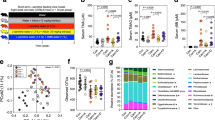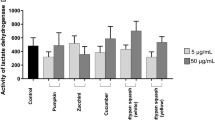Abstract
Objective: This study seeks to verify whether the regular consumption of small amounts of tomato products can protect lymphocyte DNA and lipids from oxidative damage.
Design: Standardized dietary intervention.
Subjects: Twelve healthy female subjects (mean age 25.2 y).
Intervention: Subjects were instructed to follow a standardized diet for 1 week, followed by 3 weeks consumption of the same diet enriched with small amounts of different tomato products providing as a mean 8 mg lycopene, 0.5 mg β-carotene and 11 mg vitamin C per day. Plasma and lymphocyte concentrations of carotenoids, vitamin C and vitamin E were analysed. Ex vivo protection of lymphocyte DNA from oxidative injury produced by iron ions was evaluated by means of the Comet assay, and lipid peroxidation by HPLC analysis of malondialdehyde (MDA).
Results: Dietary intervention with tomato products increased lycopene concentration both in plasma (P<0.001) and lymphocytes (P<0.01). Vitamin C concentrations increased by ∼35% in plasma (P<0.05) and by ∼230% in lymphocytes (P<0.005). Vitamin E decreased significantly in plasma (P<0.0001) but not in lymphocytes. Finally, there was an improved protection from DNA oxidative damage (P<0.05) with no significant effect on MDA levels.
Conclusions: Our results suggest that tomato products are not only good sources of lycopene but also sources of bioavailable vitamin C. A Regular intake of small amounts of tomato products can increase cell protection from DNA damage induced by oxidant species. This effect may originate from the synergism of different antioxidants present in tomatoes.
Sponsorship: Supported by the Ministry of University and Scientific Research (MURST).
This is a preview of subscription content, access via your institution
Access options
Subscribe to this journal
Receive 12 print issues and online access
$259.00 per year
only $21.58 per issue
Buy this article
- Purchase on Springer Link
- Instant access to full article PDF
Prices may be subject to local taxes which are calculated during checkout




Similar content being viewed by others
References
Agarwal S & Rao AV (1998): Tomato lycopene and low density lipoprotein oxidation: a human dietary intervention study. Lipids 33, 981–984.
Bohm F, Edge R, Burke M & Truscott TG (2001): Dietary uptake of lycopene protects human cells from singlet oxygen and nitrogen dioxide – ROS components from cigarette smoke. J. Photochem. Photobiol. B 64, 176–178.
Borel P, Grolier P, Boirie Y, Simonet L, Verdier E, Rochette Y, Alexandre-Gouabau MC, Beaufrere B, Lairon D & Azais-Braesco V (1998): Oxidative stress status and antioxidant status are apparently not related to carotenoid status in healthy subjects. J. Lab. Clin. Med. 132, 61–66.
Borg DC (1993): Oxygen free radicals and tissue injury. In: Oxygen Free Radicals in Tissue Damage, eds. Tarr M, Samson F. Boston: Birkhäuser.
Bradford MM (1976): A rapid and sensitive method for the quantitation of microgram quantities of protein utilizing the principle of protein-dye binding. Anal. Biochem. 72, 248–254.
Chaudiere J & Ferrari-Iliou R (1999): Intracellular antioxidants: from chemical to biochemical mechanisms. Food Chem. Toxicol. 37, 949–962.
Chen L, Stacewicz-Sapuntzakis M, Duncan C, Sharifi R, Ghosh L, van Breemen R, Ashton D & Bowen PE (2001): Oxidative DNA damage in prostate cancer patients consuming tomato sauce-based entrees as a whole-food intervention. J. Natl. Cancer. Inst. 93, 1872–1879.
Di Mascio P, Kaiser S & Sies H (1989): Lycopene as the most efficient biological carotenoid singlet oxygen quencher. Arch. Biochem. Biophys. 274, 532–538.
El Sohemy A, Baylin A, Kabagambe E, Ascherio A, Spiegelman D & Campos H (2002): Individual carotenoid concentrations in adipose tissue and plasma as biomarkers of dietary intake. Am. J. Clin. Nutr. 76, 172–179.
Erba D, Riso P, Criscuoli F & Testolin G (2003): Malondialdehyde production in Jurkat T cells subjected to oxidative stress. Nutrition 19, 545–548.
Evans WJ (2000): Vitamin E, vitamin C, and exercise. Am. J. Clin. Nutr. 72, 647S–652S.
Fotouhi N, Meydani M, Santos MS, Meydani SN, Hennekens CH & Gaziano JM (1996): Carotenoid and tocopherol concentrations in plasma, peripheral blood mononuclear cells, and red blood cells after long-term beta-carotene supplementation in men. Am. J. Clin. Nutr. 63, 553–558.
Gartner C, Stahl W & Sies H (1997): Lycopene is more bioavailable from tomato paste than from fresh tomatoes. Am. J. Clin. Nutr. 66, 116–122.
Gohil K, Packer L, de Lumen B, Brooks GA & Terblanche SE (1986): Vitamin E deficiency and vitamin C supplements: exercise and mitochondrial oxidation. J. Appl. Physiol. 60, 1986–1991.
Hamilton IM, Gilmore WS, Benzie IF, Mulholland CW & Strain JJ (2000): Interactions between vitamins C and E in human subjects. Br. J. Nutr. 84, 261–267.
Klebanov GI, Kapitanov AB, Teselkin Y, Babenkova IV, Zhambalova BA, Lyubitsky OB, Nesterova OA, Vasil'eva OV, Popov IN, Lewin G & Vladimirov Y (1998): The antioxidant properties of lycopene. Membr. Cell. Biol. 12, 287–300.
Marnett LJ (1999): Lipid peroxidation-DNA damage by malondialdehyde. Mutat. Res. 424, 83–95.
Nielsen F, Mikkelsen BB, Nielsen JB, Andersen HR & Grandjean P (1997): Plasma malondialdehyde as biomarker for oxidative stress: reference interval and effects of life-style factors. Clin. Chem. 43, 1209–1214.
Padayatty SJ, Katz A, Wang Y, Eck P, Kwon O, Lee JH, Chen S, Corpe C, Dutta A, Dutta SK & Levine M (2003): Vitamin C as an antioxidant: evaluation of its role in disease prevention. J. Am. Coll. Nutr. 22, 18–35.
Paetau I, Rao D, Wiley ER, Brown ED & Clevidence BA (1999): Carotenoids in human buccal mucosa cells after 4 wk of supplementation with tomato juice or lycopene supplements. Am. J. Clin. Nutr. 70, 490–494.
Porrini M & Riso P (2000): Lymphocyte lycopene concentration and DNA protection from oxidative damage is increased in women after a short period of tomato consumption. J. Nutr. 130, 189–192.
Porrini M, Riso P & Oriani G (2002): Spinach and tomato consumption increases lymphocyte DNA resistance to oxidative stress but this is not related to cell carotenoid concentrations. Eur. J. Nutr. 41, 95–100.
Porrini M, Riso P & Testolin G (1998): Absorption of lycopene from single or daily portions of raw and processed tomato. Br. J. Nutr. 80, 353–361.
Ribaya-Mercado JD, Garmyn M, Gilchrest BA & Russell RM (1995): Skin lycopene is destroyed preferentially over beta-carotene during ultraviolet irradiation in humans. J. Nutr. 125, 1854–1859.
Riso P & Porrini M (1997): Determination of carotenoids in vegetable foods and plasma. Int. J. Vitam. Nutr. Res. 67, 47–54.
Riso P, Santangelo A & Porrini M (1999a): The comet assay for the evaluation of cell resistance to oxidative stress. Nutr. Res. 19, 325–333.
Riso P, Pinder A, Santangelo A & Porrini M (1999b): Does tomato consumption effectively increase the resistance of lymphocyte DNA to oxidative damage? Am. J. Clin. Nutr. 69, 712–718.
Riso P & Porrini M. (2001): Tomatoes and health promotion. In: Vegetables, Fruits, and Herbs in Health Promotion, (ed.) RR Watson pp 45–70. Boca Raton: CRC Press.
Società Italiana di Nutrizione Umana 1996: Livelli di Assunzione Raccomandati di Energia e Nutrienti per la popolazione italiana. Roma: Edra Medical Publishing & New Media.
Stahl W & Sies H (2002): Carotenoids and protection against solar UV radiation. Skin. Pharmacol. Appl. Skin. Physiol. 15, 291–296.
Tanaka K, Hashimoto T, Tokumaru S, Iguchi H & Kojo S (1997): Interactions between vitamin C and vitamin E are observed in tissues of inherently scorbutic rats. J. Nutr. 127, 2060–2064.
Upritchard JE, Sutherland WH & Mann JI (2000): Effect of supplementation with tomato juice, vitamin E, and vitamin C on LDL oxidation and products of inflammatory activity in type 2 diabetes. Diabetes Care 23, 733–738.
Visioli F & Galli C (2002): Biological properties of olive oil phytochemicals. Crit. Rev. Food. Sci. Nutr. 42, 209–221.
Visioli F, Riso P, Grande S, Galli C & Porrini M (2003): Protective activity of tomato products on in vivo markers of lipid oxidation. Eur. J. Nutr. 42, 201–206.
Vuilleumier JP, Keller HE, Gysel D & Hunziker F (1983): Clinical chemical methods for the routine assessment of the vitamin status in human populations. Part I: The fat-soluble vitamins A and E, and beta-carotene. Int. J. Vitam. Nutr. Res. 53, 265–272.
Weisburger JH (2002): Lycopene and tomato products in health promotion. Exp. Biol. Med. 227, 924–927.
Willcox JK, Catignani GL & Lazarus S (2003): Tomatoes and cardiovascular health. Crit. Rev. Food. Sci. Nutr. 43, 1–18.
Acknowledgements
We thank Dr. John P. Doucet, Nicholls State University, who edited the manuscript.
Author information
Authors and Affiliations
Contributions
Guarantors: M Porrini and P Riso.
Contributors: PR and MP developed the experimental design and wrote the article. PR performed the Comet assay, the carotenoid and vitamin analysis and the statistical elaboration of data. FV contributed to the writing of the paper and to the critical review of data. DE performed MDA analysis and was involved in the organization of the experimental design. GT supervised the protocol.
Corresponding author
Rights and permissions
About this article
Cite this article
Riso, P., Visioli, F., Erba, D. et al. Lycopene and vitamin C concentrations increase in plasma and lymphocytes after tomato intake. Effects on cellular antioxidant protection. Eur J Clin Nutr 58, 1350–1358 (2004). https://doi.org/10.1038/sj.ejcn.1601974
Received:
Revised:
Accepted:
Published:
Issue Date:
DOI: https://doi.org/10.1038/sj.ejcn.1601974
Keywords
This article is cited by
-
The value of facial attractiveness for encouraging fruit and vegetable consumption: analyses from a randomized controlled trial
BMC Public Health (2018)
-
Life cycle assessment of spectrally tunable light engines
The International Journal of Life Cycle Assessment (2018)
-
Possible benefits of tomato juice consumption: a pilot study on irradiated human lymphocytes from healthy donors
Nutrition Journal (2017)
-
Combining vitamin C and carotenoid biomarkers better predicts fruit and vegetable intake than individual biomarkers in dietary intervention studies
European Journal of Nutrition (2016)
-
Antioxidant Bioactive Compounds in Selected Industrial Processing and Fresh Consumption Tomato Cultivars
Food and Bioprocess Technology (2013)



